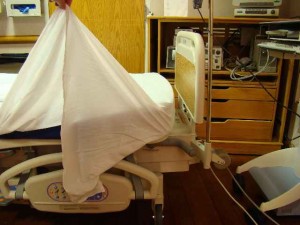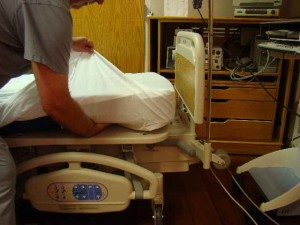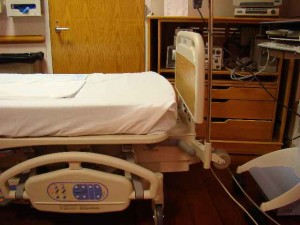Unoccupied (Closed) Bed.
An unoccupied bed is one that is made when not occupied by a patient.
- Raise the bed to a comfortable working height, if adjustable.
- Lower siderails, if present.
- Remove pillows and pillowcases. Set the pillows aside in a clean area.
- Fold and set the blankets and spreads aside (to be reused).
- Loosen the linen along the edges of the bed, and move toward the end of the bed.
- Wash the mattress if necessary, turn the mattress to the opposite side if necessary, and replace the mattress pad as needed. Observe the mattress for protruding springs.
- Place the bottom sheet.
Flat sheet.
- Position evenly on the bed.
- Miter the corners at the top of the bed. Lift the mattress slightly, then stretch and tie the ends of the sheet together beneath the mattress. Repeat these steps for the bottom of the bed.
- Stretch and tuck the free edges at the sides.
Fitted sheet.
- Fit the sheet on the lower edges of the mattress first. Then lift the mattress and fit the sheet on the top edges of the mattress.
- Stretch and tuck the free edges at the sides.
- Place a draw sheet on the center of the bed, if it is needed.
- Tuck in the free edge on one side.
Stretch the draw sheet from the opposite side and tuck in the free edge.
Place the top sheet, blanket (if used), and bedspread.
- Position evenly on the bed.
- Miter the bottom corners, tucking all three parts together.
- Leave the loose ends free.
- Fanfold the top linen back to the foot of the bed.
Place a clean pillowcase over the pillow and place it at the head of the bed.
- Invert the pillowcase over one hand so the inner back seam is visible.
- Grasp the edge of the pillow with one hand holding the pillowcase at the seam.
- Use the opposite hand to guide the pillowcase over the pillow.
Adjust the bed to its lowest position, if adjustable.
Reposition the head up slightly, if the patient prefers.
Raise the siderail opposite the side of the bed where the patient will enter.



Occupied (Open) Bed.
An occupied bed is one that is made while occupied by a patient.
- Wash your hands.
- Identify the patient, explain the procedure, and be sure you will have the patient’s cooperation.
- Check the condition of the bed linens to determine which supplies you will need.
- Provide for the patient’s privacy (throughout the procedure).
- Obtain the articles of linen that you will need.
- Place the bath blanket over the patient and the top cover.
Loosen the top bedding from the foot of the bed and remove it. If possible, have the patient hold the bath blanket while you pull the top covers from under it from the foot of the bed.
- Move the mattress to the head of the bed.
- Move the patient to the distal side of the bed.
- Make the bed on one side.
Move or turn the patient to the clean side of the bed, and finish making the bed on the opposite side. Place the clean linen on top, and remove the bath blanket.
- Attach the patient’s signal cord within reach.
- Provide for the patient’s safety and comfort.
- Tidy the room.
Anesthetic, Surgical, or Post-Op Bed.
This is a bed that is prepared to receive a patient from the operating room.
Gather all needed supplies:
- Large sheets (2).
- Drawsheet (1) or an additional large sheet.
- Blanket.
- Pillow(s).
- Pillowcase(s).
- Towel.
- Chux ®, if drainage is anticipated.
Make the bed as though you are making an unoccupied bed, except that the top sheet and blanket are not tucked under the mattress at the foot of the bed, and the corners are not mitered.
- Fanfold the top covers to the side or to the foot of the bed.
- Place a towel or disposable pad (Chux ®) at the head of the bed. This is intended to protect the sheet if the patient should vomit.
- It is a good idea to place a drawsheet on the bed because it can be used to move the patient more easily.
- Place the pillow(s) on a chair near the bed or in an upright position at the head of the bed.
Leave the bed in the high position.
Lock the brakes on the bed.
Move the furniture away from the bed to allow for easier access to the bed for the recovery room stretcher and personnel.
Make certain an emesis basin is readily available and suction is available where indicated.
Keep Chux ® available to use if necessary.
